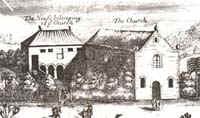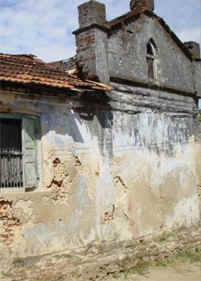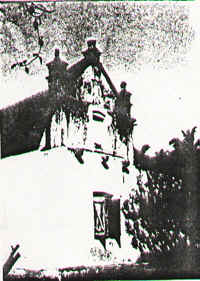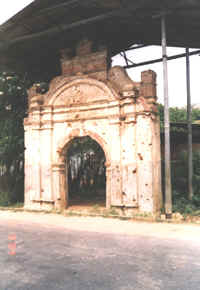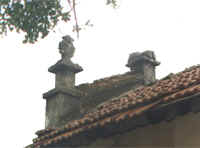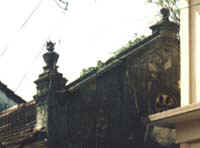 |
 |
||||||||||||||||||||||||||||||||||||||||||||||||||||||||||||||||||||||
|
Decoration and Facades - Gables
One of the most prominant element came into Jaffna Architecture due to Dutch influence was the gable ended roofs with gable walls that rose above the roof and finished with decorative copings and other elements. It seems that this was the first element that entered into the design of the traditional buildings of Jaffna as a novel decorative element. By observing the existing stock of houses and similar buildings of Jaffna, one can safely assume that the initial usage of this feature were to the side walls (Fig:2 and 3), as seen in most of the Dutch buildings, which once stood in the main street area. The sketches of the churches of Jaffna of early Dutch period shown in the book by Philip Badaeus a Dutch priest served in Jaffna during that time, shows gable walls only for the churches (Fig:1). The adjucent church houses are seen having hipped roofs. In these churches too the entrances were gained through the doors provided in the gable walls. The houses of the Dutch, in their original land in Holland, also had the gable walls as the main facade.
The usage of gables as facades in the original Dutch sense had not crept into the Jaffna building designs. This may have been due to several reasons. There is a belief among some people in Jaffna that the gable ends as facads should only be used for religious buildings. Planning considerations and even traditional "silpa sastra" rules too could have prevented its use as the facade.
Latter the concept of finishing the roof with gable walls had been brought into the front elevation as well. One should note that this was not done by bringing the gable of the main roof as facade, but by introducing secondary roofs with gables. This had been acheived by introducing a porch with a roof ridge placed perpendicular to the plane of the front elevation. Further development possibly at a very much latter date brought in more gable walls to the facade by adopting a bit more complicated roof arrangemet at the two ends of the front elevation. A more indepth
study is necessay to determine the timing of the above mentioned and other changes that took place in the facades of Jaffna houses by recording and analysing available gable types, their shapes and the motifs used, in comparision with the Portuguese, Dutch and British examples in their countries of origin and in various colonies ruled by them.
The decorations used in these gable elements commonly based on western concepts and consists of several western motifs (Fig:5, 6 and 8). However it is not uncommon to see some motifs based on local culture too. This practice most probably had come in during the late British period when awareness towards local culture increased due to various reasons. One can see "Niraikudam" (full pot), Nandhi (Seated Bull) and even some Hindu deities as motifs in these decorations (Fig:9).
|
||||||||||||||||||||||||||||||||||||||||||||||||||||||||||||||||||||||
| Last updated on 02 February 2005 | |||||||||||||||||||||||||||||||||||||||||||||||||||||||||||||||||||||||
YOUR VISITOR NO. TO THIS SITE IS  THANK YOU. THANK YOU. |
|||||||||||||||||||||||||||||||||||||||||||||||||||||||||||||||||||||||
